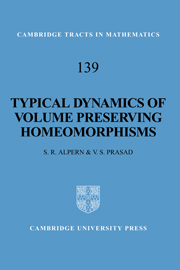Book contents
- Frontmatter
- Contents
- Historical Preface
- General Outline
- Part I Volume Preserving Homeomorphisms of the Cube
- 1 Introduction to Parts I and II (Compact Manifolds)
- 2 Measure Preserving Homeomorphisms
- 3 Discrete Approximations
- 4 Transitive Homeomorphisms of In and Rn
- 5 Fixed Points and Area Preservation
- 6 Measure Preserving Lusin Theorem
- 7 Ergodic Homeomorphisms
- 8 Uniform Approximation in G[In, λ] and Generic Properties in M[In, λ]
- Part II Measure Preserving Homeomorphisms of a Compact Manifold
- Part III Measure Preserving Homeomorphisms of a Noncompact Manifold
- Appendix 1 Multiple Rokhlin Towers and Conjugacy Approximation
- Appendix 2 Homeomorphic Measures
- Bibliography
- Index
4 - Transitive Homeomorphisms of In and Rn
Published online by Cambridge University Press: 24 August 2009
- Frontmatter
- Contents
- Historical Preface
- General Outline
- Part I Volume Preserving Homeomorphisms of the Cube
- 1 Introduction to Parts I and II (Compact Manifolds)
- 2 Measure Preserving Homeomorphisms
- 3 Discrete Approximations
- 4 Transitive Homeomorphisms of In and Rn
- 5 Fixed Points and Area Preservation
- 6 Measure Preserving Lusin Theorem
- 7 Ergodic Homeomorphisms
- 8 Uniform Approximation in G[In, λ] and Generic Properties in M[In, λ]
- Part II Measure Preserving Homeomorphisms of a Compact Manifold
- Part III Measure Preserving Homeomorphisms of a Noncompact Manifold
- Appendix 1 Multiple Rokhlin Towers and Conjugacy Approximation
- Appendix 2 Homeomorphic Measures
- Bibliography
- Index
Summary
Transitive Homeomorphisms
A mapping h of a topological space is called transitive if for any open sets U and V, there is a positive integer k with hkU ∩ V ≠ ø. For manifolds (actually, for any complete, separable metric space without isolated points) this is equivalent to the existence of a dense orbit under h. For some spaces, it is easy to exhibit transitive homeomorphisms (e.g., irrational rotations of the circle), while for other spaces where they exist more subtlety is required. Besicovitch [40] first defined such a transformation for the plane in 1937, partially answering a question of Ulam (see Chapter 12). In the same year, Oxtoby [89] used the Baire Category Theorem to demonstrate that in fact transitivity is typical for volume preserving homeomorphisms of the cube. At that time, the existence of such transformations had not been established. Recently Xu ([108, 109]) has shown how Besicovitch's transitive homeomorphism of the plane can be used to construct an explicit transitive homeomorphism of the closed unit square and Cairns, Jessup and Nicolau [48] have given examples on the 2-sphere and more generally on quotients of tori.
In this chapter we present a simplification of Oxtoby's original proof based on the combinatorial techniques of Chapter 3, and then we extend this method to show the existence of spatially periodic transitive homeomorphisms of Rn, or equivalently, rotationless homeomorphisms of the torus with transitive lifts.
- Type
- Chapter
- Information
- Typical Dynamics of Volume Preserving Homeomorphisms , pp. 22 - 30Publisher: Cambridge University PressPrint publication year: 2001



